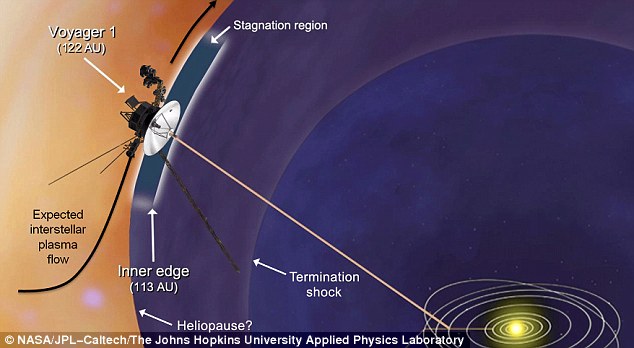
Nasa’s Voyager 1 is on the verge of becoming the first human-made object to enter interstellar space, scientists say.
First launched in 1977, the unmanned spacecraft has been in uncharted territory since last year.
Scientists had been contemplating whether it may have already have left our solar system after recording dramatic changes in radiation levels.
But new research published yesterday explains that it has not yet broken through the heliosphere, or the bubble around our Sun, and into interstellar space.
Scientists believe it remains in a transition area which has been dubbed the ‘magnetic highway’ and that it could still be some time before it breaks out.
‘It could actually be anytime or it could be several more years,’ said chief scientist Ed Stone of the Nasa Jet Propulsion Laboratory, which manages the mission.
Stone first described this unexpected zone at a meeting of the American Geophysical Union last year.
A trio of papers published online in the journal Science confirmed just how strange this new layer is.
Soon after Voyager 1 crossed into this region last August, low-energy charged particles that had been plentiful suddenly zipped outside while high-energy cosmic rays from interstellar space streamed inward.
Readings by one of Voyager 1’s instruments showed an abrupt increase in the magnetic field strength, but there was no change in the direction of the magnetic field lines — a sign that Voyager 1 has not yet exited the solar system.
Voyager 1 and its twin, Voyager 2, were launched in 1977 to visit the giant gas planets, beaming back dazzling postcards of Jupiter, Saturn and their moons.
Voyager 2 went on to tour Uranus and Neptune. After planet-hopping, they were sent on a trajectory toward interstellar space.
Voyager 1 is about 11.5billion miles from the sun. Voyager 2 is about 9.5billion miles from the sun. The nuclear-powered spacecraft have enough fuel to operate their instruments until around 2020.
In the meantime, scientists are looking for any clues of a departure.
Given the time it takes to process the data, mission scientist Leonard Burlaga said there will be a lag between when Voyager 1 finally sails into interstellar space and when the team can confirm the act.
Then there’s always the possibility of surprises beyond the solar system.
‘Crossing may not be an instantaneous thing,’ Burlaga said. ‘It may be complicated.’
Late last year researchers said Nasa’s long-running Voyager 1 spacecraft had entered a new layer of the solar system that scientists hadn’t known was there.
Scientists dubbed this region the ‘magnetic highway’ and say it’s the last stop before interstellar space, or the space between stars.
‘We do believe this may be the very last layer between us and interstellar space,’ said Edward Stone, Voyager project scientist based at the California Institute of Technology, in Pasadena, California.
‘This region was not anticipated, was not predicted.’
Therefore, it’s hard to determine how soon the spacecraft will leave the solar system altogether, Stone said at the time. ‘It may take two months, it may take two years,’ he added.
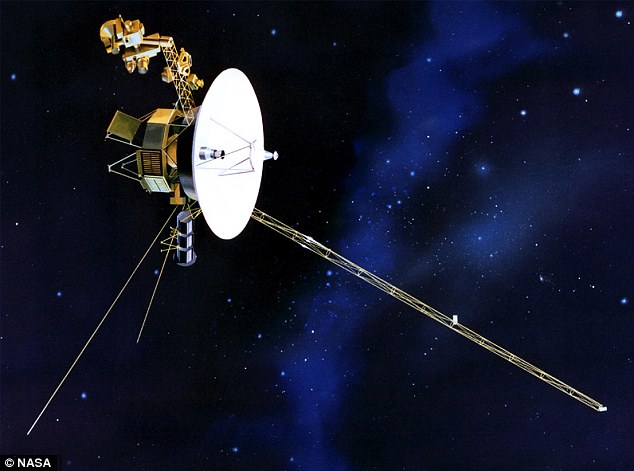
In a release, Nasa said it was referring to this new region as a magnetic highway for charged particles because our Sun’s magnetic field lines are connected there to interstellar magnetic field lines.
This connection allows lower-energy charged particles from inside our heliosphere – the bubble of charged particles the Sun blows around itself – to zoom out, and allows higher-energy particles from outside to stream in.
Before entering this region, the charged particles bounced around in all directions, as if trapped on local roads inside the heliosphere.
However, because the direction of the magnetic field lines has remained the same, the Voyager team believed the new region is still inside our solar bubble.
They predict the direction of these magnetic field lines will change when the craft breaks out into interstellar space.
Since December 2004, when Voyager 1 crossed a point in space called the termination shock, the spacecraft has been exploring the heliosphere’s outer layer, called the heliosheath.
In this region, the stream of charged particles from the sun, known as the solar wind, abruptly slowed down from supersonic speeds and became turbulent.
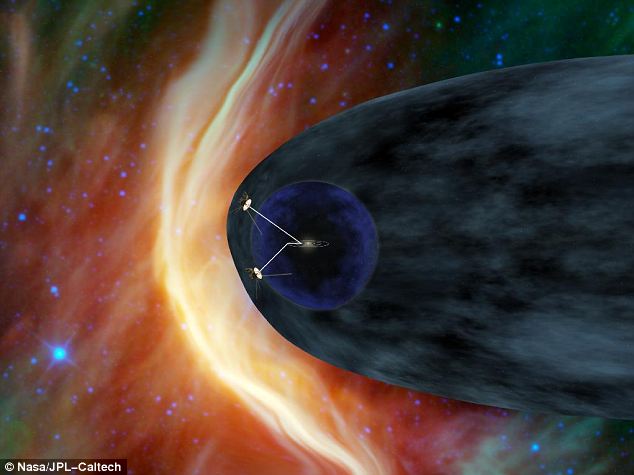
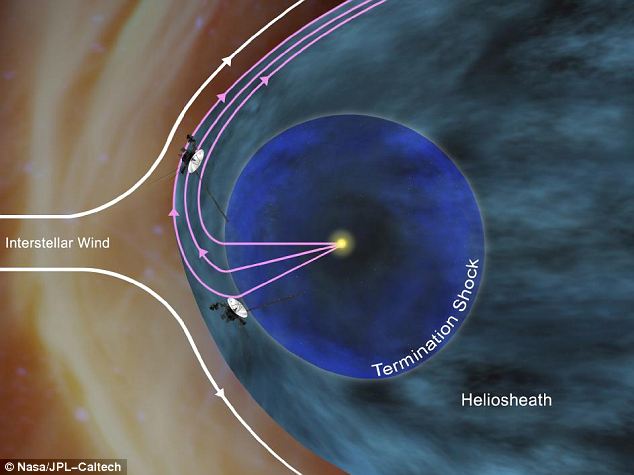
Voyager 1’s environment was consistent for about five and a half years. The spacecraft then detected that the outward speed of the solar wind slowed to nothing. The intensity of the magnetic field also began to increase at that time.
Data from two instruments aboard voyager that measure charged particles showed it first entered the magnetic highway region on July 28 last year. The region ebbed away and flowed toward Voyager 1 several times.
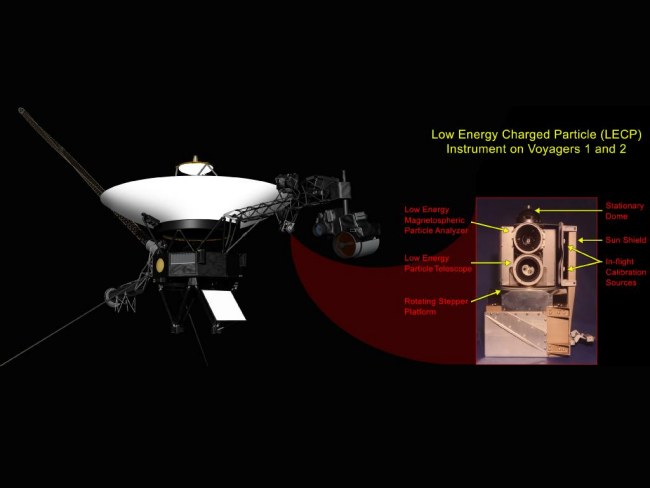
The spacecraft entered the region again August 25 and the environment has been stable since.
‘If we were judging by the charged particle data alone, I would have thought we were outside the heliosphere,’ said Stamatios Krimigis, chief scientist on the low-energy charged particle instrument.
‘But we need to look at what all the instruments are telling us and only time will tell whether our interpretations about this frontier are correct.’
Spacecraft data revealed the magnetic field became stronger each time Voyager entered the highway region; however, the direction of the magnetic field lines did not change.
‘We are in a magnetic region unlike any we’ve been in before – about ten times more intense than before the termination shock – but the magnetic field data show no indication we’re in interstellar space,’ said Leonard Burlaga, a member of the team that looks after Voyager’s magnetometer.
‘The magnetic field data turned out to be the key to pinpointing when we crossed the termination shock. And we expect these data will tell us when we first reach interstellar space.’
Voyager 1 and its sister probe Voyager 2 launched 35 years ago on a tour of the outer planets.
Voyager 2 launched on August 20, 1977, about two weeks before Voyager 1.
It is now 9billion miles from the sun. Voyager 1 launched on September 5, 1977, moving faster than its sister probe and eventually passing it.
It is now more than 11 billion miles from the sun. The signal from Voyager 1 takes approximately 17 hours to travel to Earth.
After hurtling into space, both probes have continued to travel toward the fringes of the solar system.
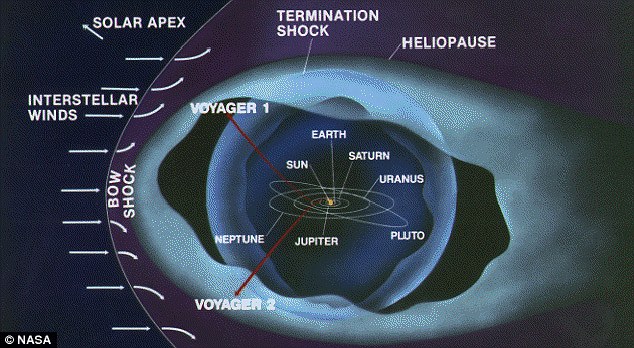
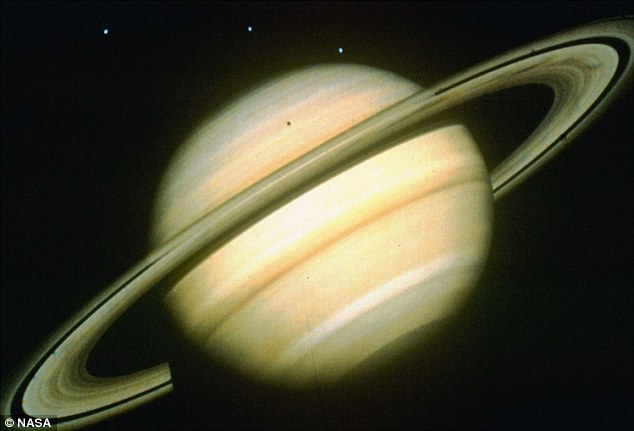
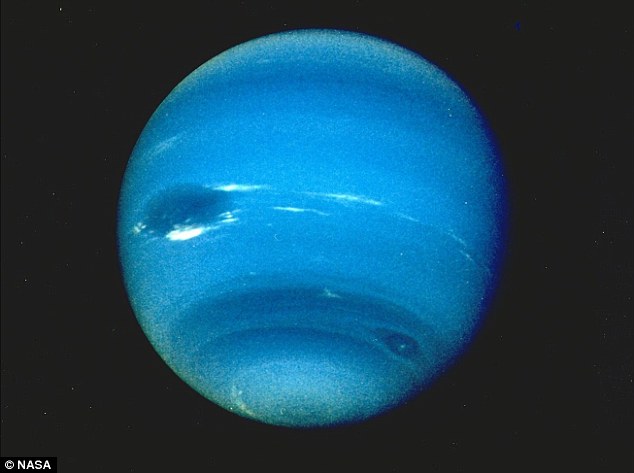
The Voyagers are NASA’s longest-running spacecraft, and will continue traveling after they have left the solar system.
As soon as Voyager 1 breaks through to interstellar space, it will be the first man-made object to leave the solar system, Stone said.
However, it would take at least 40,000 years before either probe came close to another star, Stone said.
Long before that both Voyagers will run out of power and transmit their findings back home before shutting off for good.
‘We will have enough power for all the instruments until 2020; at that point we will have to turn off our first instrument,’ Stone said.
Voyager 1 will have to be turned off by 2025.
RELATED ARTICLES
- Bible Banned! Shocking New Laws in South Dakota and Georgia
- Russian Ambassador to Washington calls USA "terrorist state", says Conquering of Ukraine will Weaken USA
- USA Issues Threat to Hungary over Continuous Support for Putin
- John Kerry Accuses Russia Of Polluting Too Much with their Ukraine War
- US F-35 jets become Nuclear Bombers











